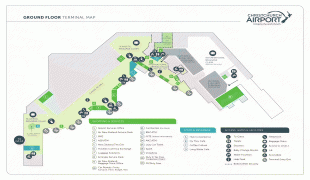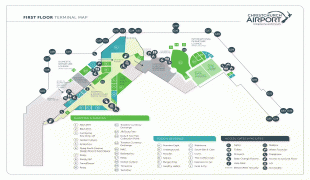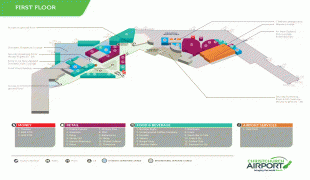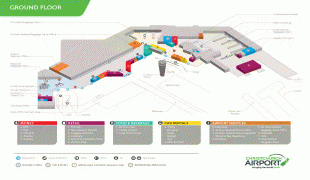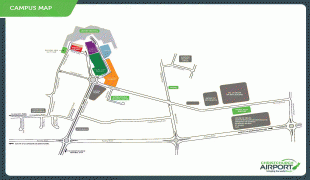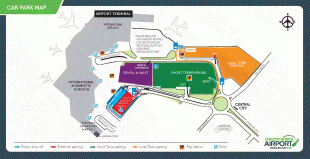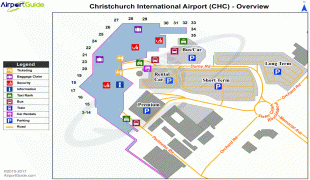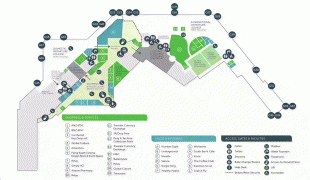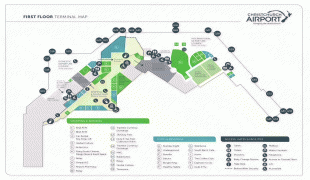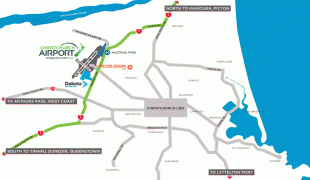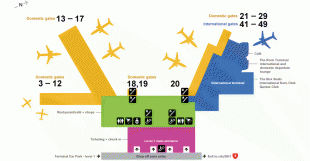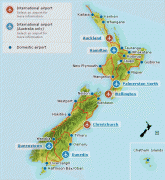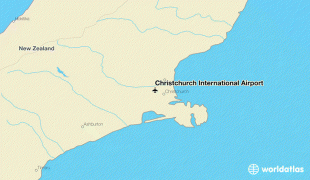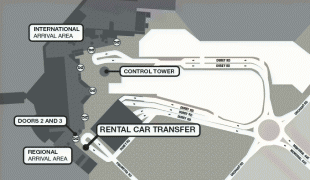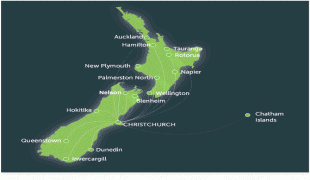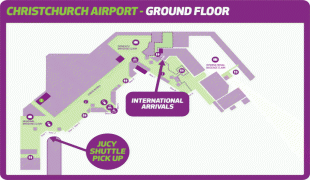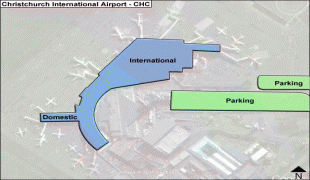Christchurch International Airport (Christchurch International Airport)
Christchurch Airport is the main airport that serves Christchurch, New Zealand. It is located 12 km to the northwest of the city centre, in the suburb of Harewood. Christchurch (Harewood) Airport officially opened on 18 May 1940 and became New Zealand's first international airport on 16 December 1950. It is the third busiest airport in New Zealand, after Auckland and Wellington, by both annual passengers and aircraft movements. Christchurch and Auckland are the only airports in New Zealand that regularly handle Boeing 747 and Airbus A380 aircraft. The airport is curfew free, operating 24 hours a day.
The prevailing wind in Christchurch is from the north-east and to a lesser extent from the south-west, but the city is also affected by Canterbury's nor'wester foehn wind. As a result, the airport has two perpendicular runways: a 3288 m primary runway (02/20) oriented with the north-easterly and south-westerly prevailing winds, and a 1741 m secondary runway (11/29) oriented for use during nor'westers. The airport also has a third grass runway, parallel to the primary runway, for use by general aviation. To serve an increasing number of passengers, the airport has completed construction of a major terminal upgrade. The new construction's primary wing opened in 2011 and the upgrade was completed in 2013.
In 1935, the local council decided to locate a new aerodrome at Harewood as the best site for Christchurch. Development of the aerodrome at Harewood commenced in 1936 when 227 hectares of land was purchased. In 1937, a 915-metre runway and a 60 square metre terminal were constructed. In 1940, the airport became RNZAF Station Harewood. By 1946 the form of the terminal area development was established with hangars, a small terminal building, the water tower and some barracks buildings. In 1950, Christchurch Airport received clearance for international operations from the government. The two runways and parallel taxiway concept was established in 1953–;runway 02/20 at 2,012 metres and 11/29 at 1,741m. In 1954, TEAL introduced Douglas DC-6 aircraft to its trans-Tasman services. In February 1960, a new terminal building, designed by architect Paul Pascoe, was brought into operation.
A 1400 ft southwest extension to runway 02/20 opened in November 1963, extending the runway to 8000 ft and providing for commercial jet operations. In April 1965, scheduled jet services were launched by Qantas to Sydney using the Boeing 707.
Later in 1966, an international wing was added to the domestic terminal. In October 1968, NAC operated its first Boeing 737 to the airport. SAFE Air introduced a Chatham Island air link to Christchurch in December 1969. In 1972 the north-west runway was completely resealed and repainted. The first scheduled Boeing 747 service to land in New Zealand arrived on 3 December 1972, a Qantas flight from Sydney. Air New Zealand introduced its McDonnell Douglas DC-10 aircraft to trans-Tasman services from 31 October 1973.
Extensions to the domestic terminal were completed in 1975 with a new two level pier added, extending the total floor space to 16,000 square metres. In October that year, Air New Zealand began a weekly DC-8 service linking Christchurch to Nadi, Rarotonga and Papeete. Air New Zealand opened its No.1 Hangar at the airport in August 1979. In December 1980 the two Australian domestic airlines Ansett and Trans Australia Airlines commenced scheduled services from Hobart within a few days of each other. In July 1984, a main runway extension was completed, the runway was lengthened 845 metres to the northeast, to a total of 3,287 metres. In February 1985, Newmans Air started scheduled de Havilland Canada Dash 7 services on the tourist routes. The first ever Air New Zealand Boeing 767 service to Melbourne and the inaugural Air New Zealand Boeing 747-200 service to Los Angeles via Honolulu and Nadi (known as the southern connection) departed in October 1985. In October 1986, Singapore Airlines started Boeing 747 services to the city. The following month, the first British Airways Boeing 747 flight from London arrived. In July 1987, Ansett New Zealand started flying on domestic trunk routes using Boeing 737 aircraft. Also in 1987, the terminal was extended to accommodate Ansett New Zealand and new Air New Zealand lounges; and domestic airbridges were added. Thai Airways began a weekly DC-10 service from Bangkok in November 1988. In March 1989, Air New Zealand introduced a weekly Boeing 747 service from Tokyo and the following month a Boeing 767 service to Perth was introduced. Although dropped years later, the Perth route was restored on a seasonal basis in 2013 with the same aircraft until 2016, when it was upgauged to a Boeing 787 Dreamliner. Also in April 1989 saw the first visit to Christchurch by a British Airways Concorde, on a world tour. In September 1990, stage 1 of the International Antarctic Centre tourist attraction was officially opened.
Air Pacific (now Fiji Airways) started a weekly direct flight to Nadi, Fiji in April 1993. Korean Airlines commenced flying to Christchurch in July 1994 using MD-11 aircraft, this was a weekly service from Seoul. In April 1997 Origin Pacific Airways started operations at the airport with flights to Nelson. The Canterbury Aero Club opened a new complex to the north-west side of the airport in October 1998. In September 1998, the new international terminal building was completed, creating an additional 28,000 square metres of floor space. In 2004, expansion of the international terminal was completed to create five more international stands and four more international airbridges. Pacific Blue Airlines commenced trans-Tasman flights from Christchurch (its New Zealand base) in January 2004. Emirates started flying to Christchurch from Dubai and Melbourne with Airbus A340 aircraft in July 2004, later switching to a Sydney-Bangkok-Dubai service with a Boeing 777-300ER aircraft before upgrading to a daily Airbus A380 service while dropping Bangkok on 30 October 2016. Jetstar started serving the city with trans-Tasman flights in December 2005. Construction of the five level carpark building commenced in March 2006. Origin Pacific ceased operations in September 2006.
In April 2011, Air Asia X commenced Airbus A330 services to Kuala Lumpur; these were short lived, ending in May 2012. China Airlines operated seasonal flights from Taipei via Sydney with Airbus A330 aircraft from December 2014 to 2018. An unusual irregular visitor is Uzbekistan Airways, which operates Boeing 767 charters from Tashkent via Kuala Lumpur carrying Russian fishing crews.
The prevailing wind in Christchurch is from the north-east and to a lesser extent from the south-west, but the city is also affected by Canterbury's nor'wester foehn wind. As a result, the airport has two perpendicular runways: a 3288 m primary runway (02/20) oriented with the north-easterly and south-westerly prevailing winds, and a 1741 m secondary runway (11/29) oriented for use during nor'westers. The airport also has a third grass runway, parallel to the primary runway, for use by general aviation. To serve an increasing number of passengers, the airport has completed construction of a major terminal upgrade. The new construction's primary wing opened in 2011 and the upgrade was completed in 2013.
In 1935, the local council decided to locate a new aerodrome at Harewood as the best site for Christchurch. Development of the aerodrome at Harewood commenced in 1936 when 227 hectares of land was purchased. In 1937, a 915-metre runway and a 60 square metre terminal were constructed. In 1940, the airport became RNZAF Station Harewood. By 1946 the form of the terminal area development was established with hangars, a small terminal building, the water tower and some barracks buildings. In 1950, Christchurch Airport received clearance for international operations from the government. The two runways and parallel taxiway concept was established in 1953–;runway 02/20 at 2,012 metres and 11/29 at 1,741m. In 1954, TEAL introduced Douglas DC-6 aircraft to its trans-Tasman services. In February 1960, a new terminal building, designed by architect Paul Pascoe, was brought into operation.
A 1400 ft southwest extension to runway 02/20 opened in November 1963, extending the runway to 8000 ft and providing for commercial jet operations. In April 1965, scheduled jet services were launched by Qantas to Sydney using the Boeing 707.
Later in 1966, an international wing was added to the domestic terminal. In October 1968, NAC operated its first Boeing 737 to the airport. SAFE Air introduced a Chatham Island air link to Christchurch in December 1969. In 1972 the north-west runway was completely resealed and repainted. The first scheduled Boeing 747 service to land in New Zealand arrived on 3 December 1972, a Qantas flight from Sydney. Air New Zealand introduced its McDonnell Douglas DC-10 aircraft to trans-Tasman services from 31 October 1973.
Extensions to the domestic terminal were completed in 1975 with a new two level pier added, extending the total floor space to 16,000 square metres. In October that year, Air New Zealand began a weekly DC-8 service linking Christchurch to Nadi, Rarotonga and Papeete. Air New Zealand opened its No.1 Hangar at the airport in August 1979. In December 1980 the two Australian domestic airlines Ansett and Trans Australia Airlines commenced scheduled services from Hobart within a few days of each other. In July 1984, a main runway extension was completed, the runway was lengthened 845 metres to the northeast, to a total of 3,287 metres. In February 1985, Newmans Air started scheduled de Havilland Canada Dash 7 services on the tourist routes. The first ever Air New Zealand Boeing 767 service to Melbourne and the inaugural Air New Zealand Boeing 747-200 service to Los Angeles via Honolulu and Nadi (known as the southern connection) departed in October 1985. In October 1986, Singapore Airlines started Boeing 747 services to the city. The following month, the first British Airways Boeing 747 flight from London arrived. In July 1987, Ansett New Zealand started flying on domestic trunk routes using Boeing 737 aircraft. Also in 1987, the terminal was extended to accommodate Ansett New Zealand and new Air New Zealand lounges; and domestic airbridges were added. Thai Airways began a weekly DC-10 service from Bangkok in November 1988. In March 1989, Air New Zealand introduced a weekly Boeing 747 service from Tokyo and the following month a Boeing 767 service to Perth was introduced. Although dropped years later, the Perth route was restored on a seasonal basis in 2013 with the same aircraft until 2016, when it was upgauged to a Boeing 787 Dreamliner. Also in April 1989 saw the first visit to Christchurch by a British Airways Concorde, on a world tour. In September 1990, stage 1 of the International Antarctic Centre tourist attraction was officially opened.
Air Pacific (now Fiji Airways) started a weekly direct flight to Nadi, Fiji in April 1993. Korean Airlines commenced flying to Christchurch in July 1994 using MD-11 aircraft, this was a weekly service from Seoul. In April 1997 Origin Pacific Airways started operations at the airport with flights to Nelson. The Canterbury Aero Club opened a new complex to the north-west side of the airport in October 1998. In September 1998, the new international terminal building was completed, creating an additional 28,000 square metres of floor space. In 2004, expansion of the international terminal was completed to create five more international stands and four more international airbridges. Pacific Blue Airlines commenced trans-Tasman flights from Christchurch (its New Zealand base) in January 2004. Emirates started flying to Christchurch from Dubai and Melbourne with Airbus A340 aircraft in July 2004, later switching to a Sydney-Bangkok-Dubai service with a Boeing 777-300ER aircraft before upgrading to a daily Airbus A380 service while dropping Bangkok on 30 October 2016. Jetstar started serving the city with trans-Tasman flights in December 2005. Construction of the five level carpark building commenced in March 2006. Origin Pacific ceased operations in September 2006.
In April 2011, Air Asia X commenced Airbus A330 services to Kuala Lumpur; these were short lived, ending in May 2012. China Airlines operated seasonal flights from Taipei via Sydney with Airbus A330 aircraft from December 2014 to 2018. An unusual irregular visitor is Uzbekistan Airways, which operates Boeing 767 charters from Tashkent via Kuala Lumpur carrying Russian fishing crews.
| IATA Code | CHC | ICAO Code | NZCH | FAA Code | |
|---|---|---|---|---|---|
| Telephone | +64 3 358 5029 | Fax | +64 3 353 7730 | ||
| Home page | Hyperlink |
Map - Christchurch International Airport (Christchurch International Airport)
Map
Country - New_Zealand
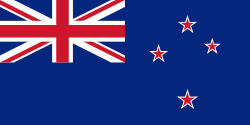 |
 |
| Flag of New Zealand | |
The islands of New Zealand were the last large habitable land to be settled by humans. Between about 1280 and 1350, Polynesians began to settle in the islands and then developed a distinctive Māori culture. In 1642, the Dutch explorer Abel Tasman became the first European to sight and record New Zealand. In 1840, representatives of the United Kingdom and Māori chiefs signed the Treaty of Waitangi, which in its English version declared British sovereignty over the islands. In 1841, New Zealand became a colony within the British Empire. Subsequently, a series of conflicts between the colonial government and Māori tribes resulted in the alienation and confiscation of large amounts of Māori land. New Zealand became a dominion in 1907; it gained full statutory independence in 1947, retaining the monarch as head of state. Today, the majority of New Zealand's population of 5.1 million is of European descent; the indigenous Māori are the largest minority, followed by Asians and Pacific Islanders. Reflecting this, New Zealand's culture is mainly derived from Māori and early British settlers, with recent broadening of culture arising from increased immigration. The official languages are English, Māori, and New Zealand Sign Language, with the local dialect of English being dominant.
Currency / Language
| ISO | Currency | Symbol | Significant figures |
|---|---|---|---|
| NZD | New Zealand dollar | $ | 2 |
| ISO | Language |
|---|---|
| EN | English language |






